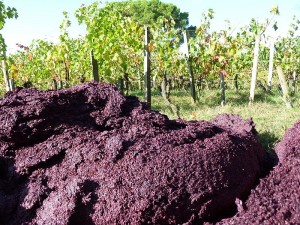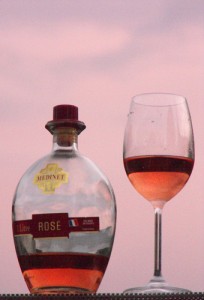Recycling or reusing grape pomace (a.k.a. grape marc) is a topic that we’ve discussed many times on The Academic Wino. Back in September of last year, I introduced a paper which should that the addition of grape marc to wines prior to bottling may increase the quality of the finished wine by increasing total phenolic content as well as total anthocyanins. Today, I present to you research by the same authors examining the use of grape marc on the quality of Rosé wines (it’s Valentine’s Day, so think pink, right?).
As you’ve heard before if you’ve read any of my previous posts on the subject, grape pomace or grape marc is loaded with antioxidants, polyphenols, flavonoids and stilbenes (think: Resveratrol). Grape pomace has been applied already in many industries, including the health, clothing, construction, and

Photo by davity dave: http://upload.wikimedia.org/wikipedia/commons/thumb/3/33/Pomace_in_the_vineyard_after_pressing.jpg/800px-Pomace_in_the_vineyard_after_pressing.jpg
wine industries (to name just a few). It is important to note, that many of the applications studied have primarily been in research only, and the widespread use of grape pomace in the real world is still well below where it could be.
To examine the effect of grape pomace addition to rose wines, the authors collected grape marc from a local juice processing facility in Spain and further processed it by dehydrating it and then grinding it up into a fine powder. The dehydrated marc (50g/L) was then added to two different white wines: one young white of Airén and one oak barrel fermented white of Airén. Maceration took place over 3 days. In proper scientific methodology, these same wines were tested without the addition of the dehydrated grape marc to serve as controls. The finished rosé wines were then stored for either 1 or 3 months at 18oC, with the following then measured and analyzed: color, phenolic composition, and volatile composition.
Highlighted Results
• At time 0, the color intensity was the same for both grape marc treated and control rosé wines.
• Grape marc treatment wines had increased levels of anthocyanins, gallic acid, (+)-catechin, caffeic acid, (-)-epicatechin, coumaric acid, quercetin, and E-resveratrol.
• Dehydrated grape marc treatment resulted in increased concentrations of linalool (3x higher than its odor threshold), geranyl acetone, and β-ionone, all of which contribute to floral characteristics in rosé wines.
• Compared with control wines, rosé wines treated with dehydrated grape marc showed a reduction in E-nerolidol and isoamyl acetate.
• Compounds contributing to wood aromas, specifically whiskylactones, were not affected by the addition of dehydrated grape marc to rosé wines.
• Volatile compound composition remained stable in treated rosé wines after three months.
• Total polyphenols increased significantly in rosé wines treated with dehydrated grape marc compared with controls (5x greater, actually).
• Color in the rosé wines treated with dehydrated grape marc remained stable over the three month period.
o This preservation was attributed to the increase levels of antioxidants in the treated wines, thus resulting in the stabilization of anthocyanin content over time.
Conclusions
The results of this study showed, according to the authors, that dehydrated grape marc may have great potential for being used as an additive in wines. Particularly, adding dehydrated grape marc during the rosé winemaking process could help stabilize the color of rosé as it ages (at least through 3 months…) and also significantly increase the beneficial antioxidants and polyphenols present in the finished wine. According to the author, the increase in antioxidants as a result of the added dehydrated grape marc could lead to protection against early oxidation in rosé wines.
Overall, I think this study has very interesting and significant applications to winemaking. Using dehydrated grape marc in wine production (particularly rosé wine production) could improve color stability over time as well as improve the aromatic profile of the finished wine. Additionally, adding grape marc to wines
could significantly improve the overall “healthiness” of the wine by increasing the health-beneficial polyphenols and antioxidant compounds. However, one thing I would like to see is a sensory analysis of these wines that have been treated with dehydrated grape marc, to ensure that the compounds found in the wines are reflected in the aromatic and sensory characteristics of the finished wine.
I’d love to hear what you all think of this study and this topic. Please feel free to leave your comments!
Source: Pedroza, M.A., Carmona, M., Salinas, M.R., and Zalacain, A. 2011. Use of Dehydrated Waste Grape Skins as a Natural Additive for Producing Rose Wines: Study of Extraction Conditions and Evolution. Journal of Agricultural and Food Chemistry 59: 10976-10986.


6 comments for “Using Grape Pomace as a Additive to Rosé Wines to Improve Wine Quality and Stability”